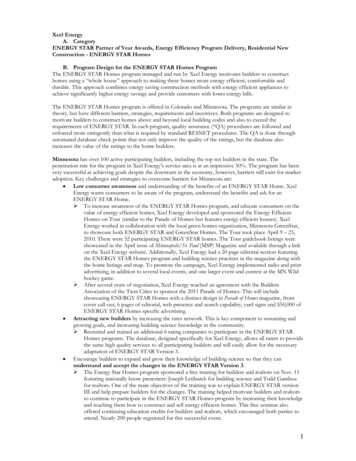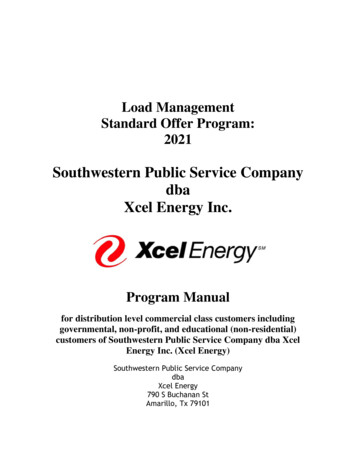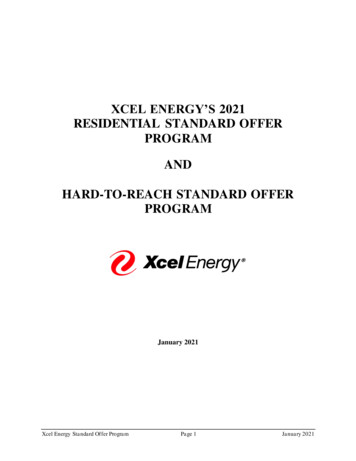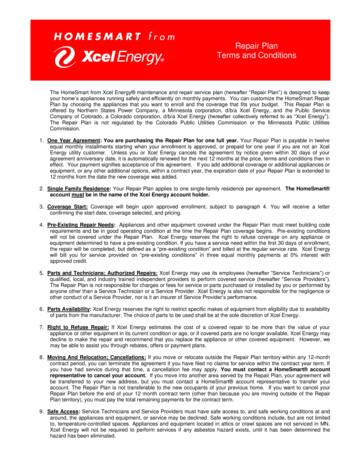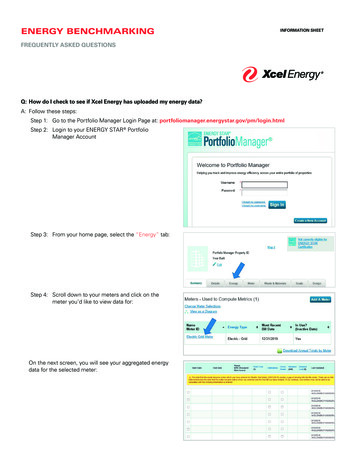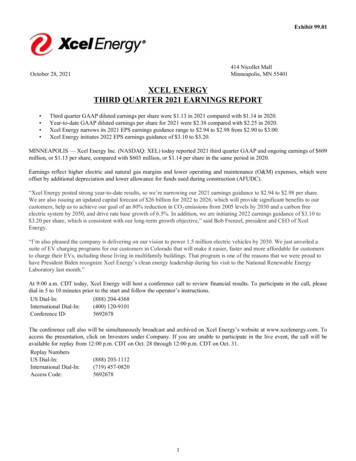
Transcription
Exhibit 99.01414 Nicollet MallMinneapolis, MN 55401October 28, 2021XCEL ENERGYTHIRD QUARTER 2021 EARNINGS REPORT Third quarter GAAP diluted earnings per share were 1.13 in 2021 compared with 1.14 in 2020.Year-to-date GAAP diluted earnings per share for 2021 were 2.38 compared with 2.25 in 2020.Xcel Energy narrows its 2021 EPS earnings guidance range to 2.94 to 2.98 from 2.90 to 3.00.Xcel Energy initiates 2022 EPS earnings guidance of 3.10 to 3.20.MINNEAPOLIS — Xcel Energy Inc. (NASDAQ: XEL) today reported 2021 third quarter GAAP and ongoing earnings of 609million, or 1.13 per share, compared with 603 million, or 1.14 per share in the same period in 2020.Earnings reflect higher electric and natural gas margins and lower operating and maintenance (O&M) expenses, which wereoffset by additional depreciation and lower allowance for funds used during construction (AFUDC).“Xcel Energy posted strong year-to-date results, so we’re narrowing our 2021 earnings guidance to 2.94 to 2.98 per share.We are also issuing an updated capital forecast of 26 billion for 2022 to 2026, which will provide significant benefits to ourcustomers, help us to achieve our goal of an 80% reduction in CO2 emissions from 2005 levels by 2030 and a carbon freeelectric system by 2050, and drive rate base growth of 6.5%. In addition, we are initiating 2022 earnings guidance of 3.10 to 3.20 per share, which is consistent with our long-term growth objective,” said Bob Frenzel, president and CEO of XcelEnergy.“I’m also pleased the company is delivering on our vision to power 1.5 million electric vehicles by 2030. We just unveiled asuite of EV charging programs for our customers in Colorado that will make it easier, faster and more affordable for customersto charge their EVs, including those living in multifamily buildings. That program is one of the reasons that we were proud tohave President Biden recognize Xcel Energy’s clean energy leadership during his visit to the National Renewable EnergyLaboratory last month.”At 9:00 a.m. CDT today, Xcel Energy will host a conference call to review financial results. To participate in the call, pleasedial in 5 to 10 minutes prior to the start and follow the operator’s instructions.US Dial-In:(888) 204-4368International Dial-In:(400) 120-9101Conference ID:5692678The conference call also will be simultaneously broadcast and archived on Xcel Energy’s website at www.xcelenergy.com. Toaccess the presentation, click on Investors under Company. If you are unable to participate in the live event, the call will beavailable for replay from 12:00 p.m. CDT on Oct. 28 through 12:00 p.m. CDT on Oct. 31.Replay NumbersUS Dial-In:(888) 203-1112International Dial-In:(719) 457-0820Access Code:56926781
Except for the historical statements contained in this report, the matters discussed herein are forward-looking statements that aresubject to certain risks, uncertainties and assumptions. Such forward-looking statements, including the 2021 and 2022 EPSguidance, long-term EPS and dividend growth rate objectives, future sales, future expenses, future tax rates, future operatingperformance, estimated base capital expenditures and financing plans, projected capital additions and forecasted annual revenuerequirements with respect to rider filings, expected rate increases to customers, expectations and intentions regarding regulatoryproceedings, and expected impact on our results of operations, financial condition and cash flows of resettlement calculationsand credit losses relating to certain energy transactions, as well as assumptions and other statements are intended to beidentified in this document by the words “anticipate,” “believe,” “could,” “estimate,” “expect,” “intend,” “may,” “objective,”“outlook,” “plan,” “project,” “possible,” “potential,” “should,” “will,” “would” and similar expressions. Actual results may varymaterially. Forward-looking statements speak only as of the date they are made, and we expressly disclaim any obligation toupdate any forward-looking information. The following factors, in addition to those discussed in Xcel Energy’s Annual Reporton Form 10-K for the fiscal year ended Dec. 31, 2020 and subsequent filings with the Securities and Exchange Commission,could cause actual results to differ materially from management expectations as suggested by such forward-lookinginformation: uncertainty around the impacts and duration of the COVID-19 pandemic; operational safety, including our nucleargeneration facilities; successful long-term operational planning; commodity risks associated with energy markets andproduction; rising energy prices and fuel costs; qualified employee work force and third-party contractor factors; ability torecover costs, changes in regulation and subsidiaries’ ability to recover costs from customers; reductions in our credit ratingsand the cost of maintaining certain contractual relationships; general economic conditions, including inflation rates, monetaryfluctuations, supply chain constraints and their impact on capital expenditures and/or the ability of Xcel Energy Inc. and itssubsidiaries to obtain financing on favorable terms; availability or cost of capital; our customers’ and counterparties’ ability topay their debts to us; assumptions and costs relating to funding our employee benefit plans and health care benefits; oursubsidiaries’ ability to make dividend payments; tax laws; effects of geopolitical events, including war and acts of terrorism;cyber security threats and data security breaches; seasonal weather patterns; changes in environmental laws and regulations;climate change and other weather; natural disaster and resource depletion, including compliance with any accompanyinglegislative and regulatory changes; and costs of potential regulatory penalties.For more information, contact:Paul Johnson, Vice President - Treasurer & Investor Relations(612) 215-4535For news media inquiries only, please call Xcel Energy Media Relations(612) 215-5300Xcel Energy website address: www.xcelenergy.comThis information is not given in connection with anysale, offer for sale or offer to buy any security.2
XCEL ENERGY INC. AND SUBSIDIARIESCONSOLIDATED STATEMENTS OF INCOME (UNAUDITED)(amounts in millions, except per share data)Three Months Ended Sept. 302021Operating revenuesElectricNatural gasOtherTotal operating revenues Operating expensesElectric fuel and purchased powerCost of natural gas sold and transportedCost of sales — otherOperating and maintenance expensesConservation and demand side management expensesDepreciation and amortizationTaxes (other than income taxes)Total operating expensesNine Months Ended Sept. 3020203,176268233,467 20212,941219223,182 20208,6431,3646910,076 1123054753(6)2991Interest charges and financing costsInterest charges — includes other financing costs of 7, 7, 22 and 21, respectivelyAllowance for funds used during construction — debtTotal interest charges and financing costs211(7)204221(11)210628(18)610628(33)595Income before income taxesIncome tax expense (benefit)Net income65243609646436031,265(17)1,282 Operating incomeOther (expense) income, netEarnings from equity method investmentsAllowance for funds used during construction — equity Weighted average common shares outstanding:BasicDilutedEarnings per average common share:BasicDiluted 539539 31.131.13 526528 1.151.14539539 2.382.381,209241,185526527 2.252.25
XCEL ENERGY INC. AND SUBSIDIARIESNotes to Investor Relations Earnings Release (Unaudited)Due to the seasonality of Xcel Energy’s operating results, quarterly financial results are not an appropriate base from which toproject annual results.Non-GAAP Financial MeasuresThe following discussion includes financial information prepared in accordance with generally accepted accounting principles(GAAP), as well as certain non-GAAP financial measures such as ongoing return on equity (ROE), electric margin, natural gasmargin, ongoing earnings and ongoing diluted EPS. Generally, a non-GAAP financial measure is a measure of a company’sfinancial performance, financial position or cash flows that adjusts measures calculated and presented in accordance withGAAP. Xcel Energy’s management uses non-GAAP measures for financial planning and analysis, for reporting of results to theBoard of Directors, in determining performance-based compensation and communicating its earnings outlook to analysts andinvestors. Non-GAAP financial measures are intended to supplement investors’ understanding of our performance and shouldnot be considered alternatives for financial measures presented in accordance with GAAP. These measures are discussed inmore detail below and may not be comparable to other companies’ similarly titled non-GAAP financial measures.Ongoing ROEOngoing ROE is calculated by dividing the net income or loss of Xcel Energy or each subsidiary, adjusted for certainnonrecurring items, by each entity’s average stockholder’s equity. We use these non-GAAP financial measures to evaluate andprovide details of earnings results.Electric and Natural Gas MarginsElectric margin is presented as electric revenues less electric fuel and purchased power expenses. Natural gas margin ispresented as natural gas revenues less the cost of natural gas sold and transported. Expenses incurred for electric fuel andpurchased power and the cost of natural gas are generally recovered through various regulatory recovery mechanisms. As aresult, changes in these expenses are generally offset in operating revenues. Management believes electric and natural gasmargins provide the most meaningful basis for evaluating our operations because they exclude the revenue impact offluctuations in these expenses. These margins can be reconciled to operating income, a GAAP measure, by including otheroperating revenues, cost of sales - other, O&M expenses, conservation and demand side management (DSM) expenses,depreciation and amortization and taxes (other than income taxes).Earnings Adjusted for Certain Items (Ongoing Earnings and Ongoing Diluted EPS)GAAP diluted EPS reflects the potential dilution that could occur if securities or other agreements to issue common stock (i.e.,common stock equivalents) were settled. The weighted average number of potentially dilutive shares outstanding used tocalculate Xcel Energy Inc.’s diluted EPS is calculated using the treasury stock method. Ongoing earnings reflect adjustments toGAAP earnings (net income) for certain items. Ongoing diluted EPS for Xcel Energy is calculated by dividing net income orloss, adjusted for certain items, by the weighted average fully diluted Xcel Energy Inc. common shares outstanding for theperiod. Ongoing diluted EPS for each subsidiary is calculated by dividing the net income or loss for such subsidiary, adjustedfor certain items, by the weighted average fully diluted Xcel Energy Inc. common shares outstanding for the period.We use these non-GAAP financial measures to evaluate and provide details of Xcel Energy’s core earnings and underlyingperformance. We believe these measurements are useful to investors to evaluate the actual and projected financial performanceand contribution of our subsidiaries. For the three and nine months ended Sept. 30, 2021 and 2020, there were no suchadjustments to GAAP earnings and therefore GAAP earnings equal ongoing earnings for these periods.4
Note 1. Earnings Per Share SummaryXcel Energy’s third quarter diluted earnings were 1.13 per share in 2021, compared with 1.14 in 2020. Higher depreciationand lower AFUDC were partially offset by higher electric and natural gas margins (driven by capital investment recovery andother regulatory outcomes) and lower O&M expenses.Summarized diluted EPS for Xcel Energy:Three Months Ended Sept. 30Diluted Earnings (Loss) Per Share2021PSCoNSP-MinnesotaSPSNSP-WisconsinEarnings from equity method investments — WYCORegulated utility (a)Xcel Energy Inc. and OtherTotal (a)(a) 0.40 0.460.250.070.011.19(0.06)1.13 20200.42 0.460.240.080.011.21(0.07)1.14 Nine Months Ended Sept. 3020210.96 0.910.480.150.032.54(0.16)2.38 20200.870.890.460.160.042.42(0.17)2.25Amounts may not add due to rounding.PSCo — Earnings decreased 0.02 per share for the third quarter of 2021 and increased 0.09 per share year-to-date. Theincrease in year-to-date earnings reflects higher natural gas and electric margins (regulatory outcomes to primarily recovercapital investments), partially offset by additional depreciation, O&M expenses and other taxes (other than income taxes).NSP-Minnesota — Earnings were flat for the third quarter of 2021 and increased 0.02 per share year-to-date. The increase inyear-to-date earnings reflects higher electric margin (regulatory outcomes to primarily recover capital investments), partiallyoffset by increased depreciation and O&M expenses.SPS — Earnings increased 0.01 per share for the third quarter of 2021 and 0.02 per share year-to-date. The increase in yearto-date earnings reflects higher electric margin (capital investment recovery and regulatory outcomes), partially offset bydecreased AFUDC.NSP-Wisconsin — Earnings decreased 0.01 per share for the third quarter of 2021 and 0.01 year-to-date. The decrease inyear-to-date earnings is largely driven by higher O&M expenses and income tax expense, partially offset by higher electricmargin and lower depreciation.Xcel Energy Inc. and Other — Primarily includes financing costs at the holding company and earnings from Energy ImpactPartners (EIP) funds equity method investments.5
Components significantly contributing to changes in 2021 EPS compared to 2020:Three MonthsEnded Sept. 30Diluted Earnings (Loss) Per ShareGAAP and ongoing diluted EPS — 2020 Components of change - 2021 vs. 2020Higher electric marginHigher natural gas marginsLower Effective Tax Rate (ETR) (a)Higher other (expense) income, netLower interest chargesLower (Higher) O&M expensesLower AFUDCHigher depreciation and amortizationOther, netGAAP and ongoing diluted EPS — 2021(a)Nine Months EndedSept. 301.14 13 ludes production tax credits (PTCs) and plant regulatory amounts, which are primarily offset in electric margin.Note 2. Regulated Utility ResultsEstimated Impact of Temperature Changes on Regulated Earnings — Unusually hot summers or cold winters increaseelectric and natural gas sales, while mild weather reduces electric and natural gas sales. The estimated impact of weather onearnings is based on the number of customers, temperature variances, the amount of natural gas or electricity historically usedper degree of temperature and excludes any incremental related operating expenses that could result due to storm activity orvegetation management requirements. As a result, weather deviations from normal levels can affect Xcel Energy’s financialperformance. However, sales true-up and decoupling mechanisms in Minnesota and Colorado predominately mitigate thepositive and adverse impacts of weather.Normal weather conditions are defined as either the 10, 20 or 30-year average of actual historical weather conditions. Thehistorical period of time used in the calculation of normal weather differs by jurisdiction, based on regulatory practice. Tocalculate the impact of weather on demand, a demand factor is applied to the weather impact on sales. Extreme weathervariations, windchill and cloud cover may not be reflected in weather-normalized estimates.Weather — Estimated impact of temperature variations on EPS compared with normal weather conditions:Three Months Ended Sept. 302021 vs.NormalRetail electricDecoupling and sales true-upElectric totalFirm natural gasTotal 0.067 (0.035)0.032 —0.032 2020 vs.NormalNine Months Ended Sept. 302021 vs.20200.079 (0.035)0.044 —0.044 2021 vs.Normal(0.012) —(0.012) —(0.012) 0.122 (0.076)0.046 0.0040.050 2020 vs.Normal2021 vs.20200.096 (0.044)0.052 (0.005)0.047 0.026(0.032)(0.006)0.0090.003Sales — Sales growth (decline) for actual and weather-normalized sales in 2021 compared to 2020:PSCoActualElectric residentialElectric C&ITotal retail electric salesFirm natural gas salesThree Months Ended Sept. 30NSP-MinnesotaSPSNSP-Wisconsin0.4 %2.11.4(2.0)0.3 %3.42.3(0.8)6(7.8)%4.41.7N/A(2.0)%1.90.8(7.8)Xcel Energy(1.0)%3.11.8(2.0)
Three Months Ended Sept. zedElectric residentialElectric C&ITotal retail electric salesFirm natural gas sales2.2 %1.81.92.22.1 %1.01.46.93.5 %2.12.5(1.8)2.6 %0.91.52.4PSCoWeather-NormalizedElectric residentialElectric C&ITotal retail electric salesFirm natural gas sales0.1 %2.21.6(4.6)(2.1)%1.50.8N/A0.9 %1.41.2(1.1)0.4 %2.01.7N/A1.2 %1.81.6(0.3)0.7 %2.42.0N/AXcel Energy2.0 %1.71.83.7Xcel Energy0.4 %3.22.4(1.0)Nine Months Ended Sept. 30 (2020 Leap Year Adjusted)NSP-MinnesotaSPSNSP-Wisconsin3.0 %1.31.93.20.5 %3.22.42.41.7 %3.63.0(0.9)Nine Months Ended Sept. zedElectric residentialElectric C&ITotal retail electric salesFirm natural gas sales(1.4)%5.33.8N/ANine Months Ended Sept. 30NSP-MinnesotaSPSNSP-WisconsinPSCoActualElectric residentialElectric C&ITotal retail electric salesFirm natural gas sales(0.3)%3.12.04.2Xcel Energy1.4 %1.51.51.0Xcel Energy0.8 %3.62.7(0.2)1.8 %1.91.91.8Weather-normalized and leap-year adjusted electric sales growth (decline) — year-to-date (excluding leap day)Weather-adjusted sales results for each of our utility subsidiaries in 2021 reflect improving economies as the adverse effects ofCOVID-19 lessen. The recovery reflects increased sales in the C&I sector as businesses return to a more normal level.Residential sales remain elevated from pre-pandemic levels due to continuance of individuals working from home. PSCo — Residential sales rose based on a 1.2% increase in customers combined with higher use per customer. Thegrowth in C&I sales was due to a 1.1% increase in customers and slightly higher use per customer, primarily in theservices sector.NSP-Minnesota — Residential sales growth reflects a 1.2% increase in customers. The growth in C&I sales was due toa 0.9% increase in customers and slightly higher use per customer, primarily in the manufacturing sector.SPS — Residential sales rose based on a 0.8% increase in customers despite slightly lower use per customer. C&Isales increased due to higher use per customer, primarily driven by the energy sector.NSP-Wisconsin — Residential sales growth was attributable to a 0.8% increase in customer additions. The growth inC&I sales was due to a 1.1% increase in customers, primarily led by increases in the services sector.Weather-normalized and leap-year adjusted natural gas sales growth (decline) — year-to-date (excluding leap day) Natural gas sales primarily reflect a 1.2% increase in residential customers and a 0.6% increase in C&I customers,combined with slightly higher customer use.Electric Margin — Electric revenues and fuel and purchased power expenses are impacted by fluctuations in the price ofnatural gas, coal and uranium. However, these price fluctuations generally have minimal impact on electric margin due to fuelrecovery mechanisms that recover fuel expenses. In addition, electric customers receive a credit for PTCs generated, whichreduce electric revenue, margin and income taxes. See Note 5 for discussion of Winter Storm Uri.7
Electric revenues and margin:Three Months Ended Sept. 30(Millions of Dollars)Electric revenuesElectric fuel and purchased powerElectric margin2021 3,176 (1,210)1,966 Nine Months Ended Sept. 30202020212,941 (981)1,960 20208,643 (3,643)5,000 7,430(2,611)4,819Changes in electric margin:Three MonthsEnded Sept. 30,2021 vs. 2020(Millions of Dollars)Non-fuel ridersRegulatory rate outcomes (Texas, New Mexico, Colorado, Wisconsin and North Dakota)Proprietary commodity trading, net of sharing (a)Sales and demand (b)Estimated impact of weather (net of decoupling/sales true-up)Texas 2019 rate case surcharge (c)PTCs flowed back to customers (offset by lower ETR)Other (net)Total increase in electric margin(a)(b)(c) Nine MonthsEnded Sept. 30,2021 vs. 202059 301110(8)(70)(31)56 1961064920(3)(70)(111)(6)181Includes 27 million of net gains previously recognized in the first quarter of 2021, driven by market changesassociated with Winter Storm Uri. Additional amounts are primarily related to long-term physical generation contracts,which have increased in value as a result of higher energy prices.Sales excludes weather impact, net of decoupling/sales true-up, and demand is net of sales true-up.Impact to electric margin is due to the Texas rate case outcome, which was recognized in the third quarter of 2020 andwas largely offset by recognition of previously deferred costs.Natural Gas Margin — Natural gas expense varies with changing sales and the cost of natural gas. However, fluctuations inthe cost of natural gas generally have minimal impact on natural gas margin due to cost recovery mechanisms. See Note 5 fordiscussion of Winter Storm Uri.Natural gas revenues and margin:Three Months Ended Sept. 30(Millions of Dollars)Natural gas revenuesCost of natural gas sold and transportedNatural gas margin2021 268 (86)182 Nine Months Ended Sept. 3020202021219 (54)165 20201,364 (603)761 1,082(425)657Changes in natural gas margin:Three MonthsEnded Sept. 30,2021 vs. 2020(Millions of Dollars)Regulatory rate outcomes (Colorado)Infrastructure and integrity ridersEstimated impact of weatherOther (net)Total increase in natural gas margin 8Nine MonthsEnded Sept. 30,2021 vs. 202013 3(1)217 84776104
O&M Expenses — O&M expenses decreased 11 million, or 1.9%, for the third quarter and increased 44 million, or 2.6%year-to-date. Significant changes are summarized as follows:Three MonthsEnded Sept. 30,2021 vs. 2020(Millions of Dollars)WindInformation technology and securityDistributionBad debt expense - PSCo settlement (See Note 4)Natural gas systemsTexas rate case deferral (offset in electric margin)BenefitsOtherTotal (decrease) increase in O&M expenses Nine MonthsEnded Sept. 30,2021 vs. 202014 3911(4)(17)(24)(3)(11) 362016115(14)(31)144The year-to-date increase was primarily due to expenses associated with new wind farms, software infrastructure and securitycosts, additional distribution expenses (vegetation management), bad debt expense related to the PSCo settlement and naturalgas damage prevention. Increases were partially offset by recognition of previous deferrals for Texas rate case activity in 2020(offset in electric margin) and a decrease in benefits expense (primarily related to long term incentives). Quarterly timingimpacts also occurred throughout 2020 due to cost control initiatives to mitigate the adverse impact of COVID-19 on sales.Depreciation and Amortization — Depreciation and amortization increased 24 million, or 4.7%, for the third quarter and 137million, or 9.5% year-to-date. The increase was primarily driven by several wind farms going into service, normal systemexpansion and the implementation of new depreciation rates in various states. In addition, depreciation for the third quarter of2020 reflected the recognition of previously deferred expenses associated with the Texas rate case.Other (Expense) Income — Other (expense) income decreased 4 million for the third quarter and increased 11 million yearto-date. Changes were largely related to fluctuations in rabbi trust performance primarily offset in O&M expenses.AFUDC, Equity and Debt — AFUDC decreased 13 million for the third quarter of 2021 and 53 million year-to-date. Thedecrease was primarily driven by completion of various wind projects.Interest Charges — Interest charges decreased 10 million, or 4.5%, for the third quarter and were flat year-to-date. Thequarter-to-date decrease was largely due to the timing of interest deferrals associated with the Texas rate case and lower interestrates, partially offset by higher debt levels primarily due to Winter Storm Uri.Earnings from Equity Method Investments — Earnings from equity method investments increased 1 million for the thirdquarter and 18 million year-to-date. The year-to-date increase was largely attributable to the performance of the EIP funds,which invest in energy technology companies.Income Taxes — Effective income tax rate:Three Months Ended Sept. 30Federal statutory rateState tax (net of federal tax effect)(Decreases) increases:Wind PTCs (a)Plant regulatory differences (b)Net operating loss carrybackOther (net)Effective income tax rate(a)(b)2021202021.0 %5.021.0 %5.0(12.1)(5.8)—(1.5)6.6 %(8.0)(7.2)(1.9)(2.2)6.7 %Nine Months Ended Sept. 302021 vs 202020212020—%—21.0 %5.021.0 %5.12021 vs 3)(1.3)%(13.2)(7.4)(1.0)(2.5)2.0 %(6.8)1.41.01.2(3.3)%Wind PTCs are credited to customers (recorded as a reduction to revenue) and do not have a material impact on netincome.Regulatory differences for income tax primarily relate to the credit of excess deferred taxes to customers through theaverage rate assumption method. Income tax benefits associated with the credit of excess deferred credits are offset bycorresponding revenue reductions.9
Income tax benefit increased 41 million year-to-date. The increase was primarily driven by an increase in wind PTCs due toadditional wind facilities going into service. Impact of PTCs was partially offset by an increase in pretax earnings, lower plantregulatory differences, a carryback tax benefit in 2020 and lower non-plant accumulated deferred income tax amortization.Note 3. Capital Structure, Liquidity, Financing and Credit RatingsXcel Energy’s capital structure:(Millions of Dollars)Percentage of TotalCapitalizationSept. 30, 2021 Current portion of long-term debtShort-term debtLong-term debtTotal debtCommon equityTotal capitalization6211,74720,97923,34715,17138,518 Percentage of TotalCapitalizationDec. 31, 20202% 5546139100 % 42158419,64520,65014,57535,2251%2565941100 %Liquidity — As of Oct. 26, 2021, Xcel Energy Inc. and its utility subsidiaries had the following committed credit facilitiesavailable to meet liquidity needs:(Millions of Dollars)Xcel Energy Inc.PSCoNSP-MinnesotaSPSNSP-WisconsinTotalTerm Loan (c)(a)(b)(c)Credit Facility (a)1,2507005005001503,1001,200Drawn (b)Available4278955—4991,200 Cash8236924914451502,601— Liquidity—725823270 8236997494471532,871 Expires June 2024.Includes outstanding commercial paper and letters of credit.Matures February 2022.Term Loan Agreements — In February 2021, Xcel Energy Inc. entered into a 1.2 billion 364-Day Term Loan Agreement inorder to enhance liquidity due to the incremental fuel costs from Winter Storm Uri and potential regulatory lag in recovery.Bilateral Credit Agreement — In April 2021, NSP-Minnesota extended an uncommitted bilateral credit agreement of 75million (which is limited in use to support letters of credit for one-year). NSP-Minnesota had 41 million of outstanding lettersof credits as of Sept. 30, 2021.Credit Ratings — Access to the capital markets at reasonable terms is partially dependent on credit ratings. The followingratings reflect the views of Moody’s, S&P Global Ratings and Fitch. The highest credit rating for debt is Aaa/AAA and thelowest investment grade rating is Baa3/BBB-. The highest rating for commercial paper is P-1/A-1/F-1 and the lowest rating isP-3/A-3/F-3. A security rating is not a recommendation to buy, sell or hold securities. Ratings are subject to revision orwithdrawal at any time by the credit rating agency and each rating should be evaluated independently of any other rating.Credit ratings assigned to Xcel Energy Inc. and its utility subsidiaries as of Oct. 26, 2021:Credit TypeSenior unsecured debtSenior secured debtCommercial paperCompanyXcel Energy Inc.NSP-MinnesotaNSP-WisconsinPSCoSPSXcel Energy Aa3Aa3A1A3P-2P-1P-1P-2P-210S&P Global RatingsBBB AAAAA-2A-2A-2A-2A-2FitchBBB A A A AF2F2F2F2F2
Capital Expenditures — Base capital expenditures and incremental capital forecasts for Xcel Energy for 2022 through 2026 areas follows:Base Capital Forecast (Millions of Dollars)2022 - 2026By Regulated Utility20222023202420252026TotalPSCo 1,930 1,850 2,070 2,220 1,860 2,290Other (a)(10)—10(30)10(20)Total base capital expenditures 5,280 4,960 5,140 5,560 5,060 26,000Base Capital Forecast (Millions of Dollars)By FunctionElectric distributionElectric transmissionElectric generationNatural gasOtherRenewablesTotal base capital expenditures(a) 20221,4851,1056456557256655,2802023 1,6001,220580670545345 4,9602024 1,5201,575670695450230 5,1402025 1,6051,965650660340340 5,5602022 - 20262026Total 1,720 7,9301,5557,4206503,1956603,3404502,510251,605 5,060 26,000Other category includes intercompany transfers for safe harbor wind turbines.The five-year capital forecast includes the proposed Colorado Pathway transmission expansion (approximately 1.7 billion), theproposed 460 MW Sherco solar facility (approximately 600 million) and the approved ALLETE wind repowering(approximately 210 million).Additional capital investment in renewable generation and transmission may be needed in the five-year forecast pendingapproval of regulatory filings in Minnesota and Colorado. The approval of the proposed resource plans could result in up to2,000 MW of renewable generation being needed between 2024 - 2026, resulting in potential capital expenditures estimatedbetween 1.0 to 1.5 billion (assuming Xcel Energy were to own 50% of the renewables). Additionally, the associated 0.5billion to 1.0 billion of network upgrades, voltage support and interconnection work related to the Colorado Power Pa
Oct 28, 2021





